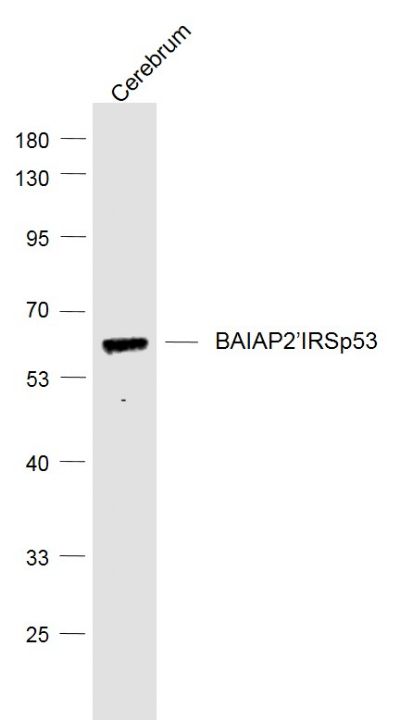The protein encoded by this gene has been identified as a brain-specific angiogenesis inhibitor (BAI1)-binding protein. This interaction at the cytoplasmic membrane is crucial to the function of this protein, which may be involved in neuronal growth-cone guidance. This protein functions as an insulin receptor tyrosine kinase substrate and suggests a role for insulin in the central nervous system. This protein has also been identified as interacting with the dentatorubral-pallidoluysian atrophy gene, which is associated with an autosomal dominant neurodegenerative disease. It also associates with a downstream effector of Rho small G proteins, which is associated with the formation of stress fibers and cytokinesis. Alternative splicing of the end of this gene results in three products of undetermined function.
Function:
Adapter protein that links membrane-bound small G-proteins to cytoplasmic effector proteins. Necessary for CDC42-mediated reorganization of the actin cytoskeleton and for RAC1-mediated membrane ruffling. Involved in the regulation of the actin cytoskeleton by WASF family members and the Arp2/3 complex. Plays a role in neurite growth. Acts syngeristically with ENAH to promote filipodia formation.
Subunit:
Homodimer. Interacts with CDC42 and RAC1 that have been activated by GTP binding. Interacts with ATN1, BAI1, EPS8, SHANK1, SHANK2, SHANK3, WASF1 and WASF2. Interacts with ENAH after recruitment of CDC42. Interacts with TIAM1 and DIAPH1. Interacts (via SH3 domain) with E.coli effector protein EspF(U) (via PXXP motifs). Interacts with E.coli intimin receptor Tir.
Subcellular Location:
Cell Membrane and Cytoplasmic.
Tissue Specificity:
Isoform 1 and isoform 4 are expressed almost exclusively in brain. Isoform 4 is barely detectable in placenta, prostate and testis. A short isoform is ubiquitous, with the highest expression in liver, prostate, testis and placenta.
Post-translational modifications:
Phosphorylated on tyrosine residues by INSR in response to insulin treatment.
Similarity:
Contains 1 IMD (IRSp53/MIM homology) domain.
Contains 1 SH3 domain.
SWISS:
Q9UQB8
Gene ID:
10458
Database links:
Entrez Gene: 10458 Human
Entrez Gene: 108100 Mouse
Entrez Gene: 117542 Rat
Omim: 605475 Human
SwissProt: Q9UQB8 Human
SwissProt: Q8BKX1 Mouse
SwissProt: Q6GMN2 Rat
Unigene: 128316 Human
Unigene: 197534 Mouse
Unigene: 95155 Rat
| Picture |
Sample:
Cerebrum (Mouse) Lysate at 40 ug
Primary: Anti-BAIAP2’IRSp53 (SLM51410M) at 1/1000 dilution
Secondary: IRDye800CW Goat Anti-Rabbit IgG at 1/20000 dilution
Predicted band size: 61 kD
Observed band size: 61 kD
|
|
|
